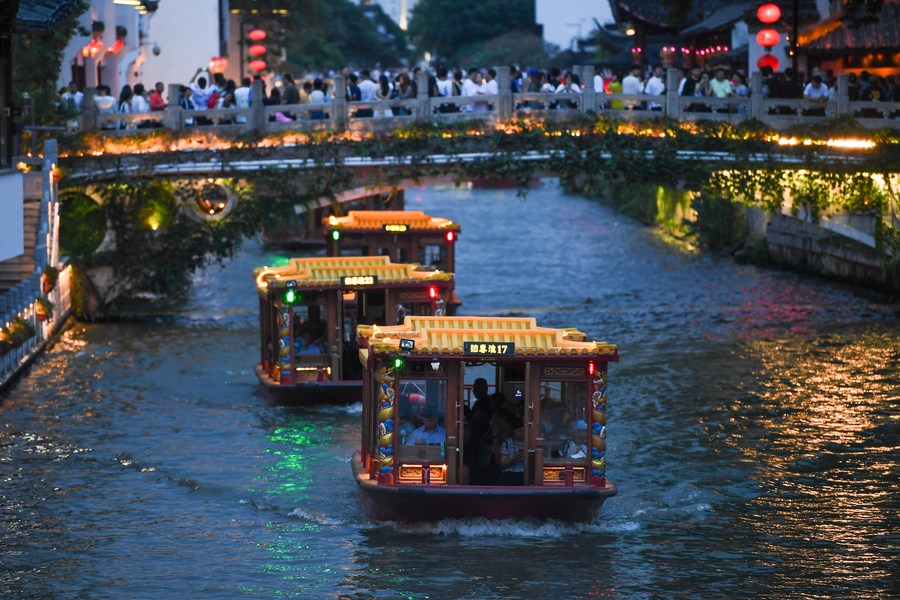
This photo taken on Aug. 21, 2023 shows tourist boats sailing on Qinhuai River in Nanjing, east China's Jiangsu Province. (Xinhua/Li Bo)
NANJING, Aug. 29 (Xinhua) -- Boasting enchanting scenery, numerous historic sites and bustling markets along the riverbanks, the Qinhuai River, a major waterway of Nanjing, capital city of east China's Jiangsu Province, serves as the cradle of ancient Jinling culture and has stood as a distinctive landmark of the country since ancient times.
During the summer, both local residents and tourists enjoy walking along the river or taking boat trips. Especially at nightfall, the ancient city of Nanjing, with a history of around 2,500 years, unveils its remarkable splendor as the intermittent sound of paddling boats mingles with the serene river, casting dancing lamp shadows that create captivating concentric circles of gentle illumination.
"The river highlights the charm of Nanjing, offering us an unforgettable cultural tour," said Chen Xin, a post-90s tourist from southwest China's Guizhou Province.
Located on the bank of the Qinhuai River, Fuzimiao, or the Confucius Temple, is a historical treasure integrating natural and cultural landscapes. It is a large architectural complex, consisting of temples, halls and commercial streets. Its main attractions include the Nanjing Imperial Examination Museum of China, which is themed on the imperial examination system in ancient China.
The museum attracted a multitude of primary school students to study the imperial examination culture during the summer holiday this year. Data shows that it received thousands of visitors daily during this period.
According to Liu Wei of the Nanjing Fuzimiao cultural tourism group, in order to inherit the millennium-old culture of Fuzimiao and cultivate new forms of tourism including research and study activities, the company has developed traditional cultural experience courses, such as movable-type printing, ancient book restoration and tie-dyeing, for young people.
In the first half of the year, the company's business segment involving research and study activities received a total of 90,000 tourists, an increase of 20 percent over the same period in 2019.
With a history spanning more than 600 years, the Xiaoxihu neighborhood boasts a wealth of historical remnants. The 46,900-square-meter block was once a run-down area in Nanjing.
Some years ago, the local government enhanced the living conditions in the block while also looking to preserve the historical elements. Since the revival, fashion stores, coffee shops, homestays, restaurants, and other kinds of businesses have opened up in the area.
Such urban renewal projects have also boosted the prosperity of the tourism sector in the ancient city. In the first half of 2023, the Qinhuai District of Nanjing, where the Fuzimiao-Qinhuai scenic belt is located, received over 35.14 million tourists, raking in a tourism revenue of more than 45 billion yuan (about 6.26 billion U.S. dollars).
Jiang Yongmei, director of culture and tourism bureau of Qinhuai District, said that the resurgence of cultural tourism consumption, exemplified by the Fuzimiao-Qinhuai scenic belt, indicates that China's cultural tourism industry is still vibrant and resilient.
"We will continue to tap new growth drivers and industry strengths to inject new vitality into the city's cultural tourism consumption," Jiang said.




 A single purchase
A single purchase









